Windemere Tennis Court Project Revisited
Ann Arbor park advisory commission meeting (Nov. 19, 2013): The main agenda item this month was a project that PAC had acted on over a year ago: The relocation of tennis courts at Windemere Park.
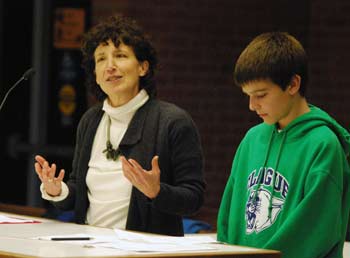
Diane Massell and Xavier Iniguez spoke to the Ann Arbor park advisory commission on Nov. 19 about the location of tennis courts in Windemere Park. (Photos by the writer.)
As part of an effort to replace the deteriorated courts, commissioners had recommended relocating them to a different spot within the park. That action took place at their meeting on Oct. 16, 2012, with the expectation that parks staff would solicit bids and seek city council approval for a construction contract to rebuild the courts in the spring of 2013.
But pushback from residents – and advocacy from city councilmember Jane Lumm, who represents Ward 2 where Windemere Park is located – led to further discussions, an online poll conducted by residents, and ultimately a return to PAC. On Nov. 19, several residents attended the meeting, including Lumm, and asked PAC to reconsider its recommendation.
Rather than relocating the courts toward the center of the park, they hoped to shift the location to the north so that more open space in the park would be preserved. PAC’s Nov. 19 meeting included a presentation in support of this option by Ed Weiss of the Earhart Knolls Homeowners Association and Jeff Alson, a resident and member of the Glacier Highlands Homeowners Association. However, one homeowner attended the meeting to disagree – her home would be closer to the courts if the location is changed.
Some commissioners expressed concern about setting precedent for a reversal of their decision, but after discussing the issue they voted unanimously to schedule another public meeting with residents. Options to consider will include the one that was originally recommended by PAC and the one that’s now being proposed by some residents as an alternative. The city might also conduct its own online poll to get additional feedback. It’s possible that the new public process will push back the project until the 2015 construction season.
Also on Nov. 19, commissioners got an update on the first four months of the fiscal year from Bob Galardi, chair of PAC’s budget and finance committee. For all parks and recreation facilities, the current projections of $3.943 million in revenues are about $52,000 over the originally budgeted amounts. In particular, revenues related to the Argo Cascades are $100,000 better than expected. On the expense side, overall costs are projected to be $5.211 million – or $50,000 less than budgeted. The fiscal year runs from July 1, 2013 through June 30, 2014, and Galardi cautioned that these projections represent an early interim report.
The meeting included several updates and reports, including news that long-time PAC member Tim Berla – who served as the representative from Ann Arbor Rec & Ed’s recreation advisory commission – will no longer be serving on PAC. He attended his last meeting in September. PAC chair Ingrid Ault expects a new RAC appointment by early 2014.
In an update from the city council, Christopher Taylor (Ward 3) – one of two council representatives who serve on PAC – noted that a park fee waiver recommended by PAC had been approved by the council on Nov. 18. The waiver is for groups who want to distribute goods for basic human needs at a city park. He also noted that on Nov. 7, the council had accepted PAC’s report on downtown parks and open space “with speed and a lack of unhappiness.” He did not mention that the other council representative on PAC, Mike Anglin (Ward 5), had dissented on that vote to accept the report.
Windemere Tennis Courts
Over a year ago – at PAC’s Oct. 16, 2012 meeting – commissioners recommended a new location for the tennis courts within Windemere Park. Commissioners had originally supported the project in May of 2012.
Windemere Park is a nearly four-acre parcel on the city’s northeast side, north of Glazier Way between Green and Earhart roads. The tennis courts there have deteriorated, and the city has been looking at options for replacing them. Neighbors had originally advocated keeping the courts in the same location, but the soil there is unstable. Before the area was developed, the current location of the courts was a pond.
In 2012, city staff has held two public meetings to seek input on options for locating the new courts. The option recommended by staff – to locate the courts to the east of the current location – was one that a majority of residents at a public meeting on Oct. 8, 2012 had favored. That location was ultimately recommended by PAC at its Oct. 16, 2012 meeting.
The cost of the project was estimated at around $100,000. Bids were expected to be solicited, with construction to take place in the summer of 2013.
However, some neighbors subsequently raised concerns about the option that was recommended by PAC – Option 4 of the four options that were considered. It had been a compromise proposal, moving the tennis courts more into the center of the existing open space at the park, farther away from homes around the perimeter of the park, compared to other options.
Because of those concerns, staff held off on construction of the new tennis courts and have been talking with residents for the past year. Residents conducted an online Doodle poll comparing the option that was recommended by PAC to one of the other options – Option 1, located slightly further to the north – that had been rejected.
Here are the four options that were considered in 2012:
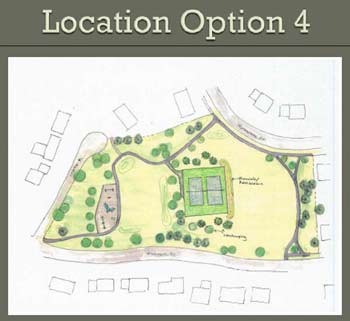
Map showing proposed relocation of Windemere Park tennis courts, as recommended by PAC on Oct. 16, 2012.
Windemere Tennis Courts: Public Commentary
Residents on both side of the issue spoke during public commentary at the start of the meeting. Rita Benn said she lives in the Windemere area but hasn’t been involved in what the neighborhood associations are putting together. She said she was notified that the associations were going to oppose the recommendation that had been made last year. On Oct. 8, 2012, three options had been presented to residents at a neighborhood meeting that she attended, she said. Option 1 is closer to her home, so she said she had a vested interest. Options 2 and 3 are closer to some of her neighbors’ homes, and preserve green space, Benn said.
A compromise was reached on an Option 4, which put the courts in between the other locations and seemed to be the best fit, she said. She described a Doodle poll that had been sent out as “quite biased,” because it didn’t present all of the options. It only presented Option 4 and Option 1, which is the closest to her home. The poll didn’t present the other two options, and was “pretty unscientific in its quality and representation.”
She said she knows it’s a difficult decision, but she urged commissioners to honor the recommendation they made in October 2012, or not to replace the tennis courts at all. Even if they didn’t consider the issues of noise or respect for her property, where she’s lived for 25 years, they should at least ask whether the location is the best in terms of terrain – as she indicated that a recent rain had left large puddles in the spot where the tennis courts are proposed to be located. She also expressed concern for what would happen to the area where the current tennis courts are located, saying that the city installed a prairie area in the park that’s now an eyesore.
Diane Massell introduced herself as a resident of the park area. She thanked commissioners for agreeing to rebuild the tennis courts, calling it a vital part of the community that’s been there for many years. She asked them to reconsider their original decision, and hoped they would shift it to Option 1 in the northeast corner of the park, which maximizes the green space that currently exists. Option 4 is in the middle of the green space, she said, which is also a vital part of the community that’s frequently used by Rec & Ed for soccer games and informally by adults and kids.
She then introduced her neighbor, Xavier Iniguez, a student who she said postponed his concert practice in order to speak to commissioners. He read a statement saying that there aren’t very many large parks in their neighborhood, so reducing the grass area would affect the sports that they play. He and his friends use the area to play baseball pick-up games in the spring and summer. In the fall, they play football and ultimate Frisbee. He hoped commissioners would consider how the location of the tennis courts could affect the amount of fun they could have at the park.
Windemere Tennis Courts: Neighborhood Association Presentation
Later in the meeting, PAC’s agenda included an item for a presentation by Ed Weiss of the Earhart Knolls Homeowners Association and Jeff Alson, a resident and member of the Glacier Highlands Homeowners Association. Weiss thanked commissioners for recommending that the city rebuild the tennis courts, calling the courts a value to residents on the east side of the city. There are other parts of the park that are also valued, he said, like the “young tot” play area and baseball diamond.
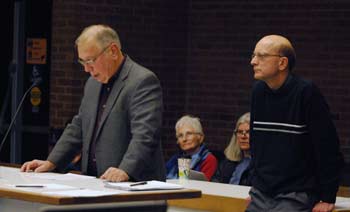
From left: Ed Weiss of the Earhart Knolls Homeowners Association and Jeff Alson, a resident and member of the Glacier Highlands Homeowners Association.
The key to the multifaceted use of the park is the open field used for organized and impromptu sports and play, Weiss said. Because so many residents have complained that Option 4 took away too much green space, one of the homeowners associations decided to bring the issue forward to PAC and seek a better remedy, Weiss said. He called Ward 2 councilmember Jane Lumm the “spark that ignited all of the parties to take up this location issue and bring it forward to a remedy that meets the expectations of the majority of residents.” Residents are requesting that the tennis courts be relocated to Option 1, rather than Option 4, he said.
Alson then spoke to PAC about an online Doodle poll that had been conducted among residents. He said that in contrast to what Rita Benn had indicated during public commentary, the poll was designed to be as neutral as possible. They had decided against going around to neighbors with a petition to change the location, and instead developed a neutral poll so that they could get a true sense of the preference among residents, Alson said. He challenged the contention that the poll was biased. [.pdf of Doodle poll text and results]
Alson reported that several residents had met a few weeks ago with parks and recreation manager Colin Smith and Sumedh Bahl, the city’s community services area administrator who supervises the parks and recreation operations. Smith and Bahl had suggested that a neutrally-worded poll was the best way to indicate what residents thought about the location of the tennis courts, Alson said, so that’s why the Doodle poll was developed. The poll targeted two groups of people, he said, based on suggestions by Smith and Bahl – residents who had attended public meetings in July and October 2012, and to houses that are on the perimeter of the park. The response rate was extremely high, Alson said. He estimated that about 55 households would fall into the two categories that were targeted, and almost two-thirds of that number responded to the poll, which had 34 responses.
The sense of the neighborhood is overwhelmingly clear, he said. Based on votes per house, the final tally was 29 votes for Option 1, and 5 for Option 4. That’s an 85% to 15% margin, he said. These poll results and the unanimous vote by the Earhart Knolls Homeowners Association Board in support of Option 1 – as well as many personal conversations over the past year – indicate an obvious preference for Option 1. He strongly urged PAC to reconsider and support Option 1, and move it ahead so that the courts can be reconstructed in 2014. He said he’s a tennis player, and it’s been about four years since there were two functional courts at Windemere Park. “We hope that none of this delays that process,” he concluded.
Windemere Tennis Courts: Commission Discussion
Alan Jackson began by noting that he was the only PAC member who attended the neighborhood meeting in 2012, and that probably puts him in the hot seat. He hadn’t anticipated that fixing the tennis courts would be controversial at all. Some of the things he was going to say probably weren’t things that the speakers would like, he said, but it’s his role to act in the public interest and he’s also a bit of a skeptic. He said he’s not a politician, so he can get away with that.
The thing to decide is whether this new information should change PAC’s original recommendation. In his opinion, Jackson said, this new information “came from a decidedly non-public process.” Because of that, it doesn’t carry the same weight. For example, he didn’t know how the poll was publicized or who had participated. He had attended the public meeting, yet he hadn’t received an email about the poll – although he ventured that it might have been marked as spam by his email program. Also, some people might not have access to email or the Internet. In addition, a poll gives people a binary decision, he said, while a public meeting is a discussion among many people.
At the public meeting Jackson had attended, he said there was near universal support for Option 4, which PAC had subsequently recommended. He indicated that it had been cool to see the neighbors reach consensus, because he hadn’t expected any kind of unanimity. His conclusion is that PAC can’t use the new information, and their only option would be to redo the process to ensure it meets the same standards. If they do that, it sets a precedent for every decision that PAC makes, he noted. “Eventually, you get to paralysis.” Cost and staff time are other factors, Jackson said. The two locations at issue aren’t very different, he added, with the main difference being that the green space isn’t contiguous in Option 4.
Ingrid Ault pointed out that there had been some transitions on PAC since the recommendation had been made in 2012, so not all commissioners were familiar with that decision. [Five of the current PAC voting members were also on the commission in October 2012: Ault, Jackson, Karen Levin, Bob Galardi and Missy Stults. Stults was attending her first meeting when PAC voted to recommend approval of the Windemere tennis court replacement. She abstained from that vote.]
Christopher Taylor, one of the two city councilmembers who serve on PAC as ex-officio non-voting members, said he wanted to both concur and differ with Jackson. The city places a “material value” on public process and public meetings as a way of gathering input. Changing a decision on the basis of “ex parte” information isn’t something he’d support. At the same time, the results of the Doodle poll, however imperfect, indicate some dissatisfaction with the outcome, Taylor noted, as does the vote of the homeowners association board. He said he’d rather slow down the process, hold another public meeting, and then take that input as the guidepost for moving forward.
Graydon Krapohl began by saying he wasn’t part of the original decision-making process. There seems to be some disconnect between what was originally decided and what people want now. It’s important to go back and reengage the residents, he said, but PAC can’t make a decision based on a Doodle poll. He also wondered why this kind of feedback wasn’t received at the beginning of the process back in 2012.
Missy Stults agreed with Taylor and Krapohl, and said she’d support holding another public meeting, but she wouldn’t be comfortable overturning PAC’s vote at this point. Bob Galardi weighed in: “Ditto.” Karen Levin also supported this approach.
Ault then expressed concern that a year after PAC’s decision, residents are now coming back asking for a reversal. “I’m concerned that this will possibly set precedent for the future and future decisions that PAC makes.” It’s PAC’s responsibility to use staff time and resources well, she added, and that needs to be part of the discussion. The timeframe is troubling for her, too. “I don’t understand why we’re having this conversation a year later.” She didn’t want to revisit every decision that PAC makes.
Galardi asked Jackson if members of the two homeowners associations had been present at the 2012 public meetings. Jackson said he couldn’t recall everyone who attended, but the Earhart Knolls Homeowners Association had been better represented. Ed Weiss, who serves on that association’s board, pointed out that the meetings weren’t specifically directed at the homeowners associations.
Jeff Straw, deputy parks and recreation manager, explained how the process had taken place. Residents who lived within a quarter-mile of the park were contacted about the meetings in 2012, he said, adding that the homeowners associations could have chosen to publicize the meetings as well. It’s the same process that the city uses with any similar process, he noted.
Straw pointed out that in order to get the project scheduled for the spring 2014 construction season, a decision will need to be made relatively soon. If a decision isn’t made by sometime in December, the project probably won’t happen in 2014.
Stults wondered why the project has been delayed, given that it was recommended for approval a year ago and had been intended to move forward during the 2013 construction season. She also wondered what it would cost to conduct another public meeting, and what other projects might get bumped. Park planner Amy Kuras replied that the cost would mostly entail staff time. The mailings to publicize a meeting would cost between $500 to $1,000. Straw added that it also depends on how much additional research will be required after the public meeting.
Regarding why the project hasn’t moved forward yet, Kuras replied that objections had been raised by residents after PAC’s decision in 2012. She said her main concern in continuing the public process at this point is that residents will never completely reach consensus. So if another public process takes place, she said, PAC and staff need to figure out ahead of time how a decision will be made – whether it’s a majority vote or some other measure. “We’re never going to make everybody happy, and so we just need to recognize that we’ll make some people more happy and some people less happy.”
Krapohl clarified that if PAC decides to hold another public meeting, it’s unlikely the project will hit the 2014 construction cycle. That’s because after the public meeting, the item would still need to be reviewed by PAC, followed by city council approval. They probably wouldn’t work through that process until January or February.
Straw pointed out that the council hasn’t yet approved the project. The council would need to approve the project’s construction contract, but it hasn’t gone that far yet. Sumedh Bahl, the city’s community services area administrator, came to the podium to expand on that explanation. After PAC decides what to do, the city will issue a request for proposals and get construction bids. After that, the council will be asked to award a contract. None of that has happened yet.
Bahl said he wanted to stress the point that Kuras had raised, saying it’s important to make sure everyone is clear about how a decision will be made. Otherwise, “we’ll be in the same position we are now,” he said.
Galardi wondered when the objections were raised after PAC’s October 2012 vote, and why PAC is only now just hearing about them. “It seems like we’re getting this rather late,” he said.
Straw replied that the staff had heard concerns from the neighborhood after PAC’s vote, and so they held off until they’d had additional discussions with residents. They felt it was now time to bring it back to PAC.
Mike Anglin, another city councilmember who serves on PAC, noted that the city residents have never rejected a parks millage. In part, that’s because the city makes a lot of effort to ensure that residents like what the city does, he said. “It’s a long, hard process.” Anglin pointed to the community input that had been received regarding Argo Dam. He agreed that any decision will disappoint a segment of the community. “Let’s hope that they understand the process,” he said. “Maybe through the process, they’ll come to a better understanding.”
Stults asked for more information from Bahl about the meeting that he and Colin Smith had with residents. Bahl replied that he and Smith had told residents that PAC had made the decision, and that nothing could be changed unless PAC wanted to reconsider its decision. That’s why residents are now asking PAC to reconsider. He said that residents were told to consider how to convey their opinion to PAC, and that evolved into the Doodle poll. The poll was sent to the email addresses of people who attended the public meetings in 2012, he said.
Ault thanked staff for their explanation. She said she’d been baffled about why this issue was coming back to PAC a year later, but now she understood. “I was just unaware that there were issues.” She didn’t think PAC was in a position to make any decision right now, other than to agree to look at what would be involved in setting another public meeting.
Taylor responded, saying that he sensed PAC was a little closer to making a decision, and that they seemed to be inclined to hold another public meeting. Jackson agreed that PAC should decide whether or not to have a public meeting, and he’d support having another public meeting, despite the cost and delay. He asked that other commissioners and homeowners get more involved this time “so that we can put this to rest.”
Stults made a motion to hold another public meeting. It was seconded by Krapohl. Galardi noted that PAC would have to somehow deal with the vote that it has already taken on this last year.
Anglin suggested that PAC make an exception and allow for additional public commentary at this point in the meeting. Ault agreed to re-open public commentary.
Windemere Tennis Courts: Additional Public Commentary & Discussion
Jane Lumm, a Ward 2 city councilmember who has been working with residents on this issue, spoke to commissioners. “I feel like I’ve set these gentlemen up,” she began, referring to Ed Weiss and Jeff Alson.
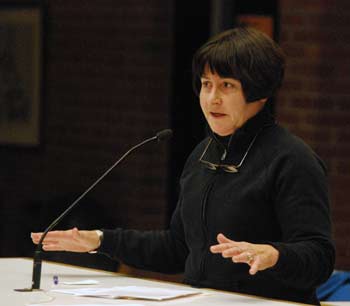
Jane Lumm, a Ward 2 city councilmember who has been working with residents on the Windemere tennis courts issue, addressed the Nov. 19 meeting of the city’s park advisory commission.
Lumm said she’s talked to more than 100 people about this issue. This fall she’d been knocking on doors as part of her re-election campaign to city council. People would ask her about the status of the tennis courts; they want the city to replace the courts, she said. Lumm told commissioners that she came to appreciate what the park means to the neighborhood. “This is all about, for me, listening to our customers, listening to our residents,” she said.
Placing the courts in the middle of the park “does gobble up a big chunk of the park,” Lumm said. It’s not just the tennis courts – it’s the proposed landscaping around the courts as well. The park is a beautiful area and the open space is well-used, she said.
One of the people who’d spoken during public commentary earlier in the meeting, Diane Massell, is married to Scott Campbell, Lumm said, who teaches urban planning at the University of Michigan. He had attended one of the many meetings that she’d also been to with residents and city staff, she said, asking for a quick revisit of this decision. “I’m here to tell you that there is consensus out there, and what people want is what you heard here today.” They want the courts replaced, but not in the center of the park. They are recommending Option 1.
Weiss and Alson had come to the city to see what they could do to make a change in the original decision, Lumm reported. She again stressed that it’s about listening to the city’s customers, saying that she has received countless emails on this subject. Her information is anecdotal, but Weiss and Alson had gotten feedback in as scientific way as they could, she said, following instructions from Smith and Bahl. This has been percolating for a year, Lumm noted – it didn’t just suddenly emerge. She urged PAC to go with the recommendation of Option 1. She then read aloud from an email she had sent to Bahl in late September 2013, which covered many of the points she’d made previously during her commentary. She strongly urged PAC to give Weiss and Alson the regard they deserve for trying to “clear the air on this.”
Ingrid Ault said she needed to confess that it had been her idea to do the Doodle poll. But she had also stipulated that the only way she’d vote for another public meeting that night is if there had been 100% consensus on that poll, she said. If even one or two people who are directly affected by this project don’t feel that they’re heard, then that’s not a good outcome, Ault said.
Christopher Taylor didn’t think Ault should perceive any censure coming from PAC about the Doodle poll. He continued to believe that it’s not enough to base a decision on, but it’s enough to identify a concern. “I think that we’re honoring that concern and we’re honoring the decision made at the initial meeting,” he said.
Alan Jackson asked park planner Amy Kuras whether she had received enough direction from PAC. Kuras said she’d reiterate her previous comments – that she’s fine with having another public meeting, as long as PAC is really clear about how the final decision will be made.
Rita Benn asked if she could address the commission again. She said her main issue with the Doodle poll is that it only presented a choice between Option 1 and Option 4. If the city holds another public meeting, she felt that all four options need to be presented. She noted that although the Earhart Knolls Homeowners Association has been very active, the other homeowners association isn’t as organized or as vocal. She said it would help to know the costs associated with each of the four options.
Finally, Benn highlighted one of the comments made anonymously on the Doodle poll, from a resident who favored Option 4. She read the comment aloud: “In the current location, the noise from the courts already wakes us up on Sunday morning. The noise includes cursing at the top of the lungs, ‘Whoops – long!’ and loud conversation. Option 4 has the courts somewhat farther away from our bedroom windows, so we prefer it. If you really don’t care about the location but do care about your neighbors’ sleep, please vote for Option 4.”
Jeff Alson also spoke again, saying he appreciated the public meetings and all the work that went into that initial decision. He pointed out that Option 4 was introduced midway through the final public meeting, and he estimated that people only talked about it for an hour. It was a not-in-my-back-yard proposal, because nobody wanted the courts next to their house. “I guess a tennis court is kind of like a toxic waste dump,” he said. Alson noted that Benn’s house will be no closer to the courts under Option 1 than she’s been for the past 25 years, compared to the current location of the courts.
Addressing the issue of why it took a year for this to come back to PAC, Alson said it took a while for people to think about Option 4 in the privacy of their homes, talking with their families and neighbors. He noted that when the city holds public meetings, they typically won’t be attended by people who have younger kids because those people don’t have the time to spend debating this issue. He said he liked the concept of public meetings, “but don’t think it’s some kind of ideal thing that makes it fair and equitable for everybody. You get a very self-selected group of folks there.” He noted that there were almost no families represented at the October 2012 neighborhood public meeting. He asked PAC to weigh the decision to choose Option 4 after only an hour at one public meeting, compared to Option 1 after a poll and nearly a year of discussion. He hoped they looked at all of the information, not just one public meeting, in determining the pulse of the neighborhood.
Kuras suggested that the city could also conduct a Survey Monkey poll as another way to get input.
Straw told commissioners that in terms of affecting the project’s timeline, it wouldn’t matter whether they voted that night or at PAC’s December meeting. If they wanted staff to gather more information, that was an option too.
Missy Stults thanked residents for their work on this issue. Public process is “hard and it’s messy,” she said, “and it’s not fun for us either.” She was leaning toward having another public meeting, but she noted that PAC wouldn’t even be considering that if the Doodle poll hadn’t happened. “So there’s success in what took place,” she said.
Karen Levin also said she appreciated the work of residents, but felt having a public meeting was necessary. Taylor also voiced support for a public meeting, saying that he originally thought it should focus on just the two choices – Options 1 or 4. Now, however, he’s persuaded that there’s “a miserable benefit in doing the whole silly thing again, and going with all the set options.” Noting that he didn’t get to vote [as a council representative to PAC], Taylor suggested that PAC move forward with this process.
Outcome: Commissioners voted unanimously to hold another public meeting about the location of the Windemere Park tennis courts.
Jeff Straw told commissioners that the staff would now set up the process for another public meeting.
Parks and Recreation Budget Update
Bob Galardi, chair of PAC’s budget and finance committee, began by joking that he thought his budget presentation would be less controversial than the Windemere tennis courts. It’s an interim report on the budget, which runs from July 1, 2013 through June 30, 2014. [.pdf of budget update through Oct. 31, 2013] [.pdf of supporting budget document]
Galardi reminded commissioners that a budget is a spending plan, based on the staff’s best research. The revenue and expense forecast, which was included in his presentation, is like a weather forecast, he said. Many items in parks and recreation are seasonal, so the numbers at this point in the fiscal year are incomplete.
He highlighted variances for some of the revenue line items. Revenues at Buhr Pool, for example, are projected to be $2,500 below budget. But at Mack Pool, where the city started a swim team, revenues are projected to be $25,000 above budgeted amounts.
Revenues at Argo Livery are projected to be $100,000 above budget – $413,500 compared to the budgeted $313,500. One of the reasons for that is that the city staff is still gaining experience there after the opening of Argo Cascades in 2012. Revenues at the Gallup Livery are projected to be $25,000 under budget, so between the two liveries, the forecast is now for $75,000 more in revenues than originally anticipated.
Turning to the golf funds, Galardi noted that Huron Hills and Leslie Park golf courses are no longer enterprise funds. [By way of background, at its Dec. 3, 2012 meeting, the Ann Arbor city council voted to moved the accounting for the city golf courses back into the general fund, starting on July 1, 2013. Mike Anglin (Ward 5), who serves on PAC, had voted against that action. The rationale for changing the accounting was that a deficit elimination plan approved by the council in 2008 had not erased the unrestricted deficit in the golf enterprise fund. The condition of the separate golf enterprise fund had caught the attention of the state treasurer’s office in 2008, which had led the council to adopt the deficit reduction plan. The council’s support of moving the golf fund back into the general fund was based in part on the idea that the golf courses should be evaluated on the same basis as other recreational facilities.]
At this point in the fiscal year, revenues are projected to be the same as budgeted at Huron Hills ($367,000) but $35,000 less than budgeted at Leslie Park ($901,000 compared to budgeted amount to $936,000).
For all the parks and recreation facilities, the projections of $3.943 million in revenues are about $52,000 higher than the budgeted amounts. On the expense side, costs are projected to be $5.211 million – or $50,000 less than budgeted. Galardi reminded commissioners that the council votes to subsidize the operations of parks and recreation. The parks and recreation staff tries to generate as much revenue as possible in order to reduce that subsidy, he said.
Galardi again stressed that this is an interim report after four months of the fiscal year has elapsed. “So where you see negative numbers … that’s yet to be determined. We have another two-thirds of the year to come.”
Jeff Straw, deputy parks and recreation manager, noted that the revenues and expenses of some facilities – like pools, liveries and golf courses – are affected by weather. Only four months of the fiscal year have passed, but right now the parks and recreation budget is tracking a little better than expected, he said.
Alan Jackson asked if there was anything that PAC should be worried about at this point. Galardi replied that it’s way too early in the year to be worried. Right now, the overall forecasted variance is $102,000 to the good, he noted. That’s not much, “but it’s still real money, and it’s real money on the right side.” Galardi said he didn’t know if the city has reached the full potential of the Argo Livery and Argo Cascades, calling it a “blessing and a curse” in that parking and other things have emerged as challenges. The staff comes up with a lot of great ideas, he added, “and some of these great ideas generate revenue.”
Communications & Commentary
There were several opportunities for communications from staff or commissioners during the Nov. 19 meeting. Here are some highlights.
Communications & Commentary: Manager’s Report
In the absence of parks & recreation manager Colin Smith, deputy manager Jeff Straw gave a brief report. The first “Dive In Movie” will be hosted at Mack Pool on Nov. 30 at 6:30 p.m. The featured film is “Monsters University,” which will be shown on the wall while kids and their families use the pool. If that goes well, the staff might plan more events like this in the future, Straw said.
Leslie Park golf course was expected to close on the weekend of Nov. 23, Straw said, because it looked like “snow may fly.” Huron Hills will stay open, however, to catch those “die-hard golfers” who still want to play.
Buhr Park ice arena opened on Nov. 9. The staff also has started to shut off the water at restrooms throughout the parks to avoid frozen pipes. Some restrooms will remain open – at Allmendinger Park, for example – through the final University of Michigan home football game on Nov. 30. After that game, those restrooms will also be closed for the season. The restrooms at the Gallup and Argo liveries will remain open for the year, as will restrooms at Southeast Area Park.
The renovation at Gallup Park is nearing completion, Straw reported.
Communications & Commentary: Dog Park
Karen Levin gave an update on the work of the dog park subcommittee. She said that with encouragement from park planner Amy Kuras, the subcommittee will formalize its process with a mission statement and master plan – rather than just starting to make recommendations for specific dog park locations. Levin said it sounds like a lot of work, but they’ve done some of it already. Also, there are master plans from other cities that can be used as templates, she noted.
Missy Stults, who also serves on the subcommittee, clarified that the subcommittee is just starting this process. Levin indicated that it won’t take a long time to develop. Ingrid Ault, another subcommittee member, called it an example of doing the process right. PAC learned from the public meetings on the dog park that they hadn’t done their homework as well as they could have, she said, so the subcommittee is taking a step back “to make sure that we don’t have a tennis court fiasco” – an allusion to the Windemere Park tennis courts issue that had been addressed earlier in the meeting. Choosing a new dog park is an issue that everyone has an opinion about “and they want to share it,” she said.
Communications & Commentary: Transitions in Membership
Ingrid Ault, PAC’s chair, noted that Tim Berla usually gives a report as the PAC member who represents the Ann Arbor Rec & Ed recreation advisory commission (RAC). However, she said, he is no longer serving on PAC, and she wanted to thank him for his service. He was on PAC for a very long time, she said, and was “truly our historian.” She noted that RAC meets quarterly and will be appointing a new liaison to PAC in early 2014. Berla had most recently attended a PAC meeting on Sept. 17, 2013 and there had been no indication that he would be stepping down.
After the meeting, Ault indicated to The Chronicle that Berla had been term limited. However, in 2012, Ann Arbor’s parks and recreation manager Colin Smith had responded to a Chronicle query about term limits by noting that Berla, as a RAC liaison, was not appointed directly to PAC by city council, and not subject to the term limits of those appointments. At that time, the RAC bylaws stated that members of RAC elect a representative to PAC every two years, at RAC’s June meeting. There was no indication in the RAC bylaws at that time that there are term limits of any kind. [.pdf of RAC bylaws] [.pdf of PAC bylaws] On Nov. 19, Ault was unclear about what had changed since then. Berla did not respond to an emailed query from The Chronicle.
The newest member of PAC – David Santacroce, who replaced Julie Grand – had been appointed by the city council on Nov. 7 but did not attend the Nov. 19 PAC meeting. He’s a professor of law at the University of Michigan, and he chaired the city’s North Main Huron River corridor task force, which worked for a year and delivered its report recently to the council on recommendations to the corridor. Grand, who had served as PAC’s representative on that task force, attended her last meeting of PAC on Oct. 15, after completing the maximum two consecutive terms of service.
Communications & Commentary: City Council Update
Christopher Taylor (Ward 3) reported that the council on Nov. 18 had approved the fee waiver for groups that want to distribute goods for basic human needs at a city park. He felt that PAC’s discussion had informed the council’s decision. [PAC had recommended approval of the waiver at its Sept. 17, 2013 meeting.]
Taylor also reported that PAC’s recommendation on downtown parks and open space was accepted by council on Nov. 7, 2013 “without controversy.” It’s a subject that people care about and tend to differ on, he added, and it’s a testament to the breadth and depth of PAC’s work that it went through “with speed and a lack of unhappiness.” [.pdf of 21-page full downtown parks report]
Taylor did not mention that the other council representative on PAC, Mike Anglin (Ward 5), had dissented on that vote to accept the report. During the council meeting Anglin had not indicated why he cast a dissenting vote, and other than Taylor’s introduction of the item, there was no discussion of the report during that Nov. 7 meeting.
The eight recommendations in that report were developed by a subcommittee and approved with only minor changes by the full commission. The recommendations are wide-ranging, but include a site-specific recommendation to develop a new park/open space area on the top of the Library Lot underground parking structure. Now a surface parking lot, the site is owned by the city and is situated just north of the Ann Arbor District Library’s downtown building. The recommendation calls for only a portion of the site to be used for a new park/open space, and stresses that AADL should be involved in the planning process.
City council representatives on PAC are ex-officio non-voting members. However, during PAC’s discussion about the report at its Oct. 15, 2013 meeting, Anglin said he was encouraged that the subcommittee recommended the Library Lot for a new park or open space. He did not indicate dissatisfaction with the report during that PAC discussion.
Present: Ingrid Ault, Bob Galardi, Alan Jackson, Graydon Krapohl, Karen Levin, Missy Stults, Jen Geer, and councilmembers Mike Anglin and Christopher Taylor (ex-officio members). Also Jeff Straw, deputy city parks and recreation manager.
Absent: David Santacroce.
Next PAC meeting: Tuesday, Dec. 17, 2013 at 4 p.m. in the city hall second-floor council chambers, 301 E. Huron St., Ann Arbor. [Check Chronicle event listing to confirm date]
The Chronicle survives in part through regular voluntary subscriptions to support our coverage of public bodies like the Ann Arbor park advisory commission. If you’re already helping The Chronicle with some financial green, please encourage your friends, neighbors and coworkers to do the same. Click this link for details: Subscribe to The Chronicle.







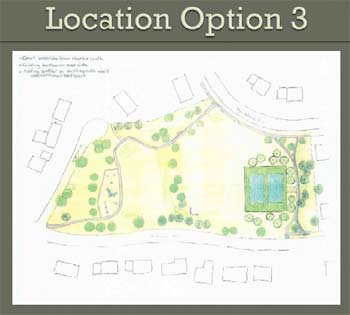
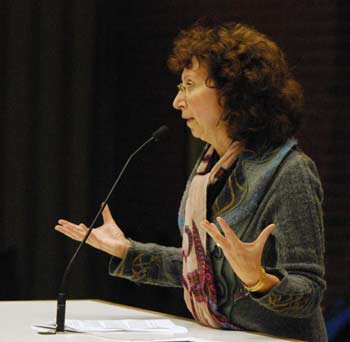

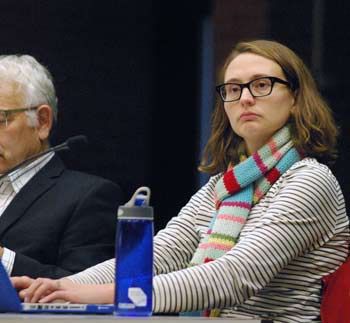
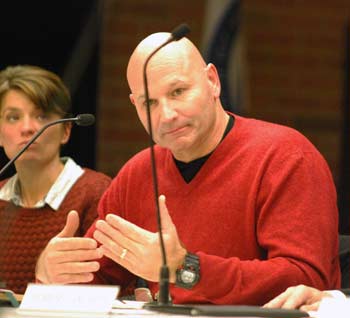

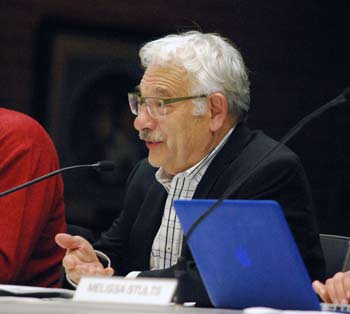
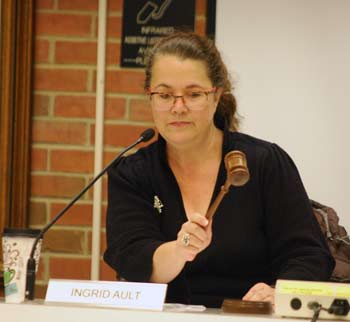
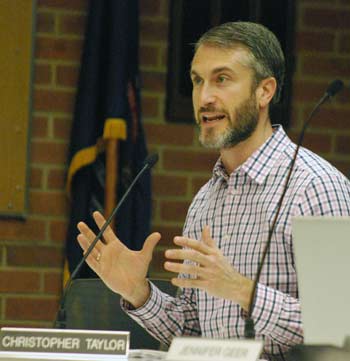
“Some commissioners expressed concern about setting precedent for a reversal of their decision…”
Yeah, those pesky members of the public and taxpayers getting in the way of the Commission. The nerve of them.
I wonder if commenters like this have ever volunteered for the city. I’d recommend it—it tends to bring out the constructive side in some people.
Congratulations to PAC for grappling with this difficult decision re the Windemere tennis courts. I agree with the point that decisions should not be revisited in most cases. This is because continuous churning on decisions will result in complete inaction and gridlock for any public process. Also, it sets up the potential for combat between various interests, with the current decision dependent on ability to mobilize.
On the other hand, decisions that essentially push an unwelcome result down the throats of a minority are abhorrent.It appears that PAC is dealing with the problem in a sensitive and responsible way, by putting the decision on hold while another public meeting is held. I hope that they will receive enough information to make a decision that is equitable and acceptable to all parties.
Mary
In the background of the photo of Graydon Krapohl there is a woman who is not listed on either the ‘Present’ or ‘Absent’ list. I seem to remember you recently pointing her out as new to this board.
Re. “…a woman who is not listed on either the ‘Present’ or ‘Absent’ list.”
Thanks for the catch. It’s Jen Geer, one of the newer PAC members. Her first PAC meeting was June 18, 2013, but I failed to add her to the present/absent list. I’ve made that correction.
There is now a survey on the A2 Open City Hall site. [link]